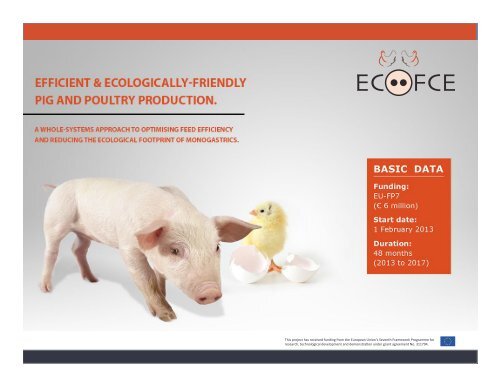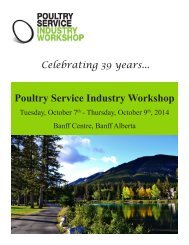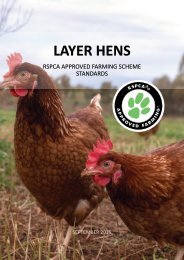Pigs-and-poultry_Improving-feed-efficiency_Ruminomics-ECOFCE-workshop-Aberdeen-16-June-2014
Create successful ePaper yourself
Turn your PDF publications into a flip-book with our unique Google optimized e-Paper software.
This project has received funding from the European Union‘s Seventh Framework Programme for <br />
research, technological development <strong>and</strong> demonstraon under grant agreement No. 311794.
<strong>Improving</strong> <strong>feed</strong> <strong>efficiency</strong> by <br />
underst<strong>and</strong>ing the intesnal bacterial <br />
network in pigs <strong>and</strong> <strong>poultry</strong> <br />
Dr. Barbara Metzler-‐Zebeli <br />
Mr. Andor Molnar <br />
Ms. Janine Scholz <br />
University of Veterinary Medicine <br />
Vienna <br />
Dr. Stefan G. Buzoianu <br />
Dr. Peadar G. Lawlor <br />
Ms. Ursula McCormack <br />
Moorepark Research Centre, <br />
Teagasc, Irel<strong>and</strong> <br />
This project has received funding from the European Union‘s Seventh Framework Programme for <br />
research, technological development <strong>and</strong> demonstraon under grant agreement No. 311794.
Introducon <br />
This project has received funding from the European Union‘s Seventh Framework Programme for <br />
research, technological development <strong>and</strong> demonstraon under grant agreement No. 311794.
• Feb 2013 – Feb 2017 <br />
• 17 partners <br />
• 7 WPs <br />
• Overall objecves <br />
ECO-‐FCE overview <br />
• improve food security by opmising the <strong>feed</strong> <strong>efficiency</strong> in pigs <strong>and</strong> broilers <br />
without negavely affecng animal welfare <strong>and</strong> meat quality <br />
• reduce the ecological footprint of the pig <strong>and</strong> broiler producon systems <br />
• WP 3 objecve <br />
• to examine the gut structure, funcon, microbiota <strong>and</strong> metagenomics in <br />
animals divergent for <strong>feed</strong> <strong>efficiency</strong> <br />
This project has received funding from the European Union‘s Seventh Framework Programme for <br />
research, technological development <strong>and</strong> demonstraon under grant agreement No. 311794.
Work Package 3 <br />
Intesnal <br />
structure & <br />
funcon <br />
Genomics <br />
Genecs <br />
Low <br />
RFI <br />
Intesnal <br />
health <br />
High <br />
Medium <br />
Health & <br />
welfare <br />
Meat quality <br />
Animal <br />
performance <br />
Intesnal <br />
microbiota <br />
This project has received funding from the European Union‘s Seventh Framework Programme for <br />
research, technological development <strong>and</strong> demonstraon under grant agreement No. 311794.
Determinaon of <strong>feed</strong> <strong>efficiency</strong> <br />
Selecon of high <strong>and</strong> low <strong>feed</strong> efficient animals -‐ based on Residual Feed Intake <br />
Residual Feed Intake (RFI) = difference between observed <strong>and</strong> predicted <strong>feed</strong> <br />
intake, with lower RFI values indicang greater energy <strong>efficiency</strong> <br />
RFI = FI [a + b 1 * BW 0.75 + b 2 * BWG] <br />
Where a is the intercept <strong>and</strong> b 1 <strong>and</strong> b 2 are paral regression coefficients of <strong>feed</strong> intake <br />
(FI) on BW 0.75 <strong>and</strong> body weight gain (BWG), respecvely. <br />
Other measures of <strong>feed</strong> <strong>efficiency</strong> <br />
Feed <strong>efficiency</strong> = gain (g) / <strong>feed</strong> intake (g) <br />
Feed conversion rao (FCR) = <strong>feed</strong> intake <br />
(g) / gain (g) <br />
RG = BWG [a + b 1 * BW 0.75 + b 2 * FI] <br />
RIG = (RG/SD RG) -‐ (RFI/SD RFI) <br />
This project has received funding from the European Union‘s Seventh Framework Programme for <br />
research, technological development <strong>and</strong> demonstraon under grant agreement No. 311794.
Feed <strong>efficiency</strong> in monogastric livestock <br />
species <br />
Feed <br />
<strong>efficiency</strong> <br />
Genecs <br />
Diet <br />
Rearing <br />
environment <br />
Age <br />
Gut commensal microbiota <br />
Substanal variaon in <strong>feed</strong> <strong>efficiency</strong> between individual animals. <br />
Great variaon in gut commensal microbiota between individuals. <br />
This project has received funding from the European Union‘s Seventh Framework Programme for <br />
research, technological development <strong>and</strong> demonstraon under grant agreement No. 311794.
Role of the intesnal microbiota <br />
Benefits to the host <br />
intesnal maturaon <br />
inhibion of pathogen growth <br />
nutrient salvaging <br />
detoxificaon <br />
producon of vitamins <br />
Costs to the host <br />
compeon for nutrients <br />
immune acvaon <br />
producon of toxins <br />
opportunisc <br />
toxin reabsorpon <br />
mucolyc acvity <br />
This project has received funding from the European Union‘s Seventh Framework Programme for <br />
research, technological development <strong>and</strong> demonstraon under grant agreement No. 311794.
Effect of host microbiota on host metabolism <strong>and</strong> <br />
hormone secreon <br />
Intesnal microbiota can <br />
redirect energy <br />
paroning to adipose <br />
ssue <strong>and</strong> reduce fay <br />
acid oxidaon. <br />
Bäckhed (2011) Ann Nutr Metab 58(suppl 2):44 <br />
Implicaons for <strong>feed</strong> use <br />
<strong>efficiency</strong> <strong>and</strong> carcass <br />
composion in livestock <br />
animals? <br />
This project has received funding from the European Union‘s Seventh Framework Programme for <br />
research, technological development <strong>and</strong> demonstraon under grant agreement No. 311794.
Effect of gut microbiota composion on body <br />
weight <br />
Obese humans & mice: <br />
Firmicutes á <br />
Bacteroidetes â <br />
Low-‐calorie diet <br />
Firmicutes â <br />
Bacteroidetes á <br />
wikipedia.org <br />
Acnobacteria á <br />
Bacteroidetes â <br />
no difference in Firmicutes <br />
Changes in Lactobacillus <strong>and</strong> Bifidobacterium species <br />
Methanogenic archaea á <br />
Requena et al. (2013) Trends Food Sci Tech 34:44 <br />
Meat-‐producing monogastric livestock species are young, fast <br />
growing <strong>and</strong> lean animals <br />
Are the key players the same as in human obesity models ? <br />
This project has received funding from the European Union‘s Seventh Framework Programme for <br />
research, technological development <strong>and</strong> demonstraon under grant agreement No. 311794.
Chickens <br />
This project has received funding from the European Union‘s Seventh Framework Programme for <br />
research, technological development <strong>and</strong> demonstraon under grant agreement No. 311794.
Diet-‐related cecal microbiota <strong>and</strong> performance in <br />
male chickens <br />
Caecal microbial communies by diet Caecal microbial communies idenfied <br />
as being from birds with improved <br />
performance or poorer performance <br />
Diet is the most influencing factor affecng <strong>feed</strong> <strong>efficiency</strong>. <br />
Torok et al. (2011) AEM 77: 5868 <br />
This project has received funding from the European Union‘s Seventh Framework Programme for <br />
research, technological development <strong>and</strong> demonstraon under grant agreement No. 311794.
Batch to batch variaon in caecal microbiota <br />
of chickens <br />
3 different batches of chickens <br />
Very different microbiota <br />
profiles across chicken batches <br />
PCA plot of caecal microbiota. The plot <br />
is based on between groups (trials) <br />
analysis. <br />
Very different <strong>feed</strong> use <br />
efficiencies across chicken <br />
batches <br />
Stanley et al. (2013) PloS ONE 8(12): e84290 <br />
High variaon in caecal microbiota partly due to lack of colonisaon of the chickens by <br />
maternally derived bacteria <br />
⇒ High hygiene levels in modern commercial hatcheries remove natural bacteria <br />
⇒ Environmental microbiota from transport boxes, first <strong>feed</strong> <strong>and</strong> staff people <br />
This project has received funding from the European Union‘s Seventh Framework Programme for <br />
research, technological development <strong>and</strong> demonstraon under grant agreement No. 311794.
Fecal community of high <strong>and</strong> low <strong>feed</strong> efficient <br />
broiler chickens <br />
Low efficient chickens<br />
High efficient chickens<br />
12<br />
7<br />
Proteobacteria (%)<br />
18<br />
79<br />
Firmicutes (%)<br />
Bacteroidetes (%)<br />
28<br />
52<br />
Singh et al. (<strong>2014</strong>) J Appl Genet 55: 145 <br />
This project has received funding from the European Union‘s Seventh Framework Programme for <br />
research, technological development <strong>and</strong> demonstraon under grant agreement No. 311794.
Characterisaon of differences in gut microbiota <strong>and</strong> gut <br />
funcon of chickens with good <strong>and</strong> poor <strong>feed</strong> <strong>efficiency</strong> <br />
Experimental design: <br />
2 partner instuons (AFBI & Vetmeduni) performed idencal chicken experiments <br />
with 3 batches of 50/64 chicks <br />
Similar chicken genec: Cobb 500FF <br />
Similar maize-‐soybean meal diets (starter, grower, <strong>and</strong> finisher diets) <br />
No in-‐<strong>feed</strong> anbiocs <strong>and</strong> any other gut health-‐related addives <br />
Chickens were individually housed <br />
Best <strong>and</strong> worst <strong>feed</strong> efficient chickens were idenfied using Residual Feed Intake <br />
Ammonia<br />
Metagenomics Metagenomics Metagenomics<br />
emission<br />
(faeces) (faeces) (faeces)<br />
(faeces)<br />
Weighing Weighing Weighing Weighing Weighing Weighing<br />
d1 d7 d14 d21<br />
d28 d35<br />
d42<br />
Daily <strong>feed</strong> intake<br />
On day 42, samples were collected for: <br />
Ileal <strong>and</strong> caecal digesta for metagenomics <strong>and</strong> microbial metabolites <br />
Tissue of duodenum, jejunum, ileum, caeca for gut funcon <strong>and</strong> structure <br />
This project has received funding from the European Union‘s Seventh Framework Programme for <br />
research, technological development <strong>and</strong> demonstraon under grant agreement No. 311794.
Residual <strong>feed</strong> intake of good <strong>and</strong> poor <strong>feed</strong> efficient <br />
broiler chickens <br />
300<br />
200<br />
Residual <strong>feed</strong> intake<br />
Male<br />
Female<br />
(g)<br />
100<br />
0<br />
Great variaon in residual <br />
<strong>feed</strong> intake <strong>and</strong> thus in <br />
<strong>feed</strong> use <strong>efficiency</strong>. <br />
-‐100<br />
-‐200<br />
-‐300<br />
Feed <strong>efficiency</strong>, P< 0.001<br />
Batch, P>0.1<br />
Good Average Poor<br />
This project has received funding from the European Union‘s Seventh Framework Programme for <br />
research, technological development <strong>and</strong> demonstraon under grant agreement No. 311794.
Microbial metagenome of good <strong>and</strong> poor <strong>feed</strong> efficient <br />
chickens <br />
Shotgun sequencing using MiSeq Technology <br />
(Illumina) <br />
Under construcon <br />
This project has received funding from the European Union‘s Seventh Framework Programme for <br />
research, technological development <strong>and</strong> demonstraon under grant agreement No. 311794.
Jejunal electrophysiological characteriscs of good <br />
<strong>and</strong> poor <strong>feed</strong> efficient broiler chickens <br />
Gut electrophysiology was performed using Ussing chamber technique. <br />
Tissue originated from the distal jejunum. <br />
200<br />
150<br />
100<br />
50<br />
0<br />
Tissue resistance (Ω/cm 2 )<br />
Females<br />
Feed <strong>efficiency</strong>, P=0.020<br />
b<br />
a<br />
Good Average Poor<br />
a<br />
14<br />
12<br />
10<br />
8<br />
6<br />
4<br />
2<br />
0<br />
Tissue conductance (mS x cm 2 )<br />
a<br />
b<br />
Females<br />
Feed <strong>efficiency</strong>, P=0.002<br />
b<br />
Good Average Poor<br />
1.6<br />
1.4<br />
1.2<br />
1.0<br />
0.8<br />
0.6<br />
0.4<br />
0.2<br />
0.0<br />
Short-‐circuit current (I sc ; µEq/cm 2 x hour)<br />
a<br />
ab<br />
Females<br />
Feed <strong>efficiency</strong>, P=0.076<br />
Good Average Poor<br />
b<br />
Good <strong>feed</strong> efficient females showed lower ssue resistance, higher conductance <strong>and</strong> <br />
short-‐circuit current indicang a higher ion flux <strong>and</strong> permeability of the jejunal mucosa <br />
Influencing factors: Host genome or gut microbiota ? <br />
This project has received funding from the European Union‘s Seventh Framework Programme for <br />
research, technological development <strong>and</strong> demonstraon under grant agreement No. 311794.
<strong>Pigs</strong> <br />
This project has received funding from the European Union‘s Seventh Framework Programme for <br />
research, technological development <strong>and</strong> demonstraon under grant agreement No. 311794.
Literature <br />
Lile data available in pigs <br />
↓ Bacteroidetes & ↑ Firmicutes in obese pigs (Pedersen et al., 2013) <br />
↑ Firmicutes & ↓ β-‐Proteobacteria in ERS-‐fed pigs (Haenen et al., 2013) <br />
Protein, CHO <strong>and</strong> lipid metabolic pathways affected by <br />
intesnal microbial profile <br />
mice (Antunes et al., 2011) <br />
pigs (Mulder et al., 2009) <br />
This project has received funding from the European Union‘s Seventh Framework Programme for <br />
research, technological development <strong>and</strong> demonstraon under grant agreement No. 311794.
Screening on <strong>feed</strong> <strong>efficiency</strong> in pigs <br />
46 liers <br />
<strong>Pigs</strong> <br />
divergent <br />
for RFI <br />
Common <br />
protocols <br />
Teagasc × 3 <br />
AFBI <br />
Vetmeduni <br />
Common <br />
diets <br />
Common <br />
genecs <br />
Common <br />
& site-specific<br />
<br />
boars <br />
weaning d 42 d 84 <br />
P <br />
F <br />
F <br />
P <br />
d 112 <br />
This project has received funding from the European Union‘s Seventh Framework Programme for <br />
research, technological development <strong>and</strong> demonstraon under grant agreement No. 311794.<br />
<br />
F I C <br />
F – faecal <br />
I – ileal digesta <br />
C – caecal digesta <br />
P – performance
Microbiota profiling <br />
d 0 (weaning) d 42 d 84 d 126 d 139 <br />
P <br />
P <br />
P <br />
P <br />
F F F F F I C <br />
Composional analysis <br />
<strong>16</strong>S rRNA gene sequencing <br />
Illumina <br />
Funconality <br />
Shotgun metagenomics <br />
F – faecal; I – ileal digesta; C – caecal digesta; P – performance <br />
This project has received funding from the European Union‘s Seventh Framework Programme for <br />
research, technological development <strong>and</strong> demonstraon under grant agreement No. 311794.
Progress on microbiota profiling <br />
Samples collected <br />
DNA extracted <br />
<strong>16</strong>S rRNA gene sequencing – results being analysed <br />
Shotgun metagenomics <br />
samples being prepared <br />
results ~ Oct <strong>2014</strong> <br />
This project has received funding from the European Union‘s Seventh Framework Programme for <br />
research, technological development <strong>and</strong> demonstraon under grant agreement No. 311794.
Manipulaon of GIT microbial profile <br />
Addives <br />
Microbial <br />
inoculaon <br />
Low RFI <br />
Management <br />
Nutrion <br />
This project has received funding from the European Union‘s Seventh Framework Programme for <br />
research, technological development <strong>and</strong> demonstraon under grant agreement No. 311794.
Inoculaon with faecal inoculum from good <strong>feed</strong> <br />
converters <br />
Anaerobically processed <br />
diluted 1:6 <br />
strained <br />
centrifuged (6000 × G for 15 minutes) <br />
frozen at -‐80°C in 10% glycerol <br />
No <br />
inoculum <br />
Sows <br />
Inoculum <br />
No <br />
inoculum <br />
Single <br />
inoculaon <br />
Mulple <br />
inoculaon <br />
Offspring <br />
No <br />
inoculum <br />
Single <br />
inoculaon <br />
Mulple <br />
inoculaon <br />
This project has received funding from the European Union‘s Seventh Framework Programme for <br />
research, technological development <strong>and</strong> demonstraon under grant agreement No. 311794.
Nutrional intervenon <br />
Opmum strategy – inoculum <br />
Prebiocs – alone or in combinaon <br />
Monitoring <strong>and</strong> sampling of offspring through their lifeme <br />
performance <br />
health <br />
intesnal microbiota <br />
This project has received funding from the European Union‘s Seventh Framework Programme for <br />
research, technological development <strong>and</strong> demonstraon under grant agreement No. 311794.
Acknowledgements <br />
ECO-‐FCE has received funding from the European Union’s <br />
Seventh Framework Programme for research, technological <br />
development <strong>and</strong> demonstraon (FP7 2007/2013) under grant <br />
agreement No. 311794 <br />
Teagasc Walsh Fellowship Programme <br />
This project has received funding from the European Union‘s Seventh Framework Programme for <br />
research, technological development <strong>and</strong> demonstraon under grant agreement No. 311794.
Thank you <br />
This project has received funding from the European Union‘s Seventh Framework Programme for <br />
research, technological development <strong>and</strong> demonstraon under grant agreement No. 311794.
This project has received funding from the European Union‘s Seventh Framework Programme for <br />
research, technological development <strong>and</strong> demonstraon under grant agreement No. 311794.
ECO-‐FCE <br />
Gut structure, funcon, microbiota <strong>and</strong> metagenomics <br />
Hypothesis: <br />
It is assumed that the gut microbiome of pigs <strong>and</strong> broiler chickens with good <strong>and</strong> <br />
poor <strong>feed</strong> use <strong>efficiency</strong> differs in key members, thereby influencing the <br />
intesnal <strong>and</strong> metabolic host response, producon <strong>efficiency</strong> <strong>and</strong> host health. <br />
Objecves: <br />
1. To enhance our underst<strong>and</strong>ing of the interacons between gut microbiome <strong>and</strong> host <br />
genome in pigs <strong>and</strong> chickens. This task will be achieved by employing cung-‐edge <br />
<strong>16</strong>S rRNA-‐specific <strong>and</strong> shotgun metagenomics. <br />
2. Using this improved underst<strong>and</strong>ing, strategies to improve <strong>feed</strong> conversion <strong>efficiency</strong> <br />
through gut microbiome manipulaon in embryonic <strong>and</strong> subsequent developmental <br />
stages will be developed. <br />
This project has received funding from the European Union‘s Seventh Framework Programme for <br />
research, technological development <strong>and</strong> demonstraon under grant agreement No. 311794.
Interacons between gut microbiome <strong>and</strong> host <br />
physiology <strong>and</strong> health <br />
NF-‐κB <br />
This project has received funding from the European Union‘s Seventh Framework Programme for <br />
research, technological development <strong>and</strong> demonstraon under grant agreement No. 311794.<br />
<br />
Bäckhed (2011) Ann Nutr Metab 58(suppl 2): 44; Twarziok et al. (<strong>2014</strong>) Mol Inf 33: 171







